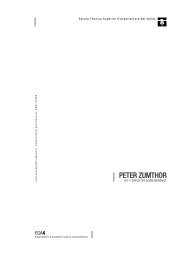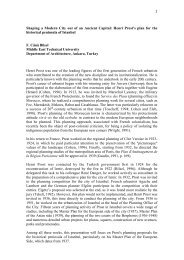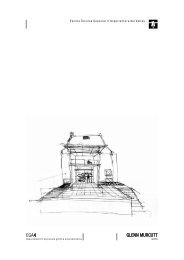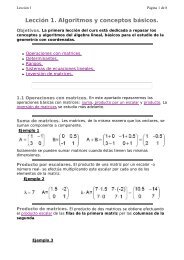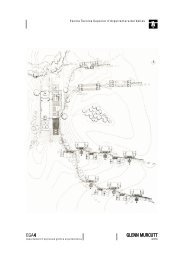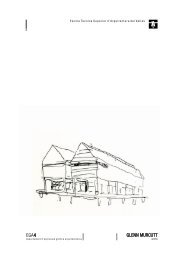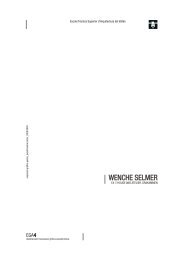Create successful ePaper yourself
Turn your PDF publications into a flip-book with our unique Google optimized e-Paper software.
www.etsav.upc.es/urbpersp Andrea Peresthu<br />
Growth by Polarization<br />
The growth by polarization that commenced in the mid<br />
of 90s can be seen and analyzed using these following<br />
frameworks.<br />
[1] The Insular growth: the urban sprawl was<br />
continuing, but in a different scale and scope. It<br />
becomes more complex overtime, for instance many<br />
empty or unproductive farmlands, which were never<br />
considered as valuable and strategic, suddenly were<br />
transformed into hospitals, warehouses, universities,<br />
and golf courses 4 .<br />
[2] The ex-novo growth: Obviously, those new<br />
functions and projects were established or clustered<br />
along the highway corridors to guarantee accessibility 5 .<br />
Some of them demanded and insisted to have a direct<br />
exclusive access from the highways. This created an<br />
unbalanced and crowded road-connection system<br />
between the highways and the secondary roads, which<br />
then caused many physical damages to the roads and<br />
very serious traffic jams.<br />
[3] The Integrated linkage network: Immediately after<br />
Jabotabek linkage structure was completed and well<br />
connected with the airport, port, and highways, Jakarta<br />
was no longer considered as the center of the regional<br />
nexus anymore.<br />
[4] The reticular polarization: The urban growth has<br />
also shown other symptoms of massive amenities and<br />
facilities agglomerations in some new emerging cities<br />
within Jabotabek 6 . This trend is visible in the new city<br />
4 In 1994, government revised master plan as well as regional plan,<br />
which is known as Jabotabek Metropolitan Development Plan<br />
Review – JMDPR. This revised plan includes 18 largest scale,<br />
residential, amenities, and new town projects proposed by private<br />
developers [JICA, 1994].<br />
5 The accumulation of highway length increased from 46 kilometers<br />
by 1978 [which connected Jakarta – Bogor] to 285.9 kilometers by<br />
the end of 1996, and recently it has around 390 kilometers total<br />
highways length in Jabotabek area [Peresthu, 2001: 37]<br />
6 The prominent new towns built or planned by private real estate<br />
developers in BOTABEK Region are among others: In the regency<br />
of Tangerang, West of Jakarta : the Bumi Serpong Damai (BSD)<br />
New Town of about 6,000 hectares; Tigaraksa New Town of about<br />
3,100 hectares and Lippo Village, Karawaci of about 2,600 hectares;<br />
Pantai Jndah Kapuk of about 800 hectares; Alam Sutera of about 700<br />
hectares; Kapuk Naga, 8,000 hectaers; Binatro Jaya of about 2,300<br />
of Lippo Karawaci that is located roughly 35<br />
kilometers to the west of Jakarta. This new city is<br />
perhaps the most "prestigious" city that Indonesia has<br />
ever had. It is the headquarter location of the powerful<br />
business group, Lippo. It consists of a five star hotel,<br />
university, international standard hospital, cultural<br />
center, small-scale airport, shopping mall, and indeed a<br />
golf course 7 .<br />
This recent urban growth indeed has a direct impact on<br />
the socio-spatial transformation of Jakarta. Inevitably,<br />
environmental damages cannot be avoided.<br />
Tremendous social crisis also exploded across<br />
Jabotabek. For instance, the more eager are the<br />
capitalists to acquire lands to cater their businesses or<br />
just to engage in speculative deals, the more frequent<br />
hectares; Citra Raya New Town, 2,000 Hectares; Modern Land of<br />
770 hectares; Citra Grand City of about 1,000 hectares; Villa<br />
Permata of about 700 hectares and Palm Spring Village of about 100<br />
hectares; Pun Jaya City, about 2,000 hectares, and others are in the<br />
pipeline such as the Citraland New Town and the Serpong Gading<br />
New Town. In the regency of Bekasi, East of Jakarta: the Bekasi<br />
Integrated New Town of about 1,300 hectares, Cikarang Baru New<br />
Town of about 5,400 hectares; Bekasi 2000 New Town of about<br />
2,000 hectares, Lippo Cikarang of about 5000 hectares, Legend New<br />
City of about 2,000 hectares and Bekasi New City which is planned<br />
to develop an area of about 3,000 hectares, Bumi Bekasi Baru New<br />
Town, 1,500 Hectares. Others are in the regency of Bogor, South of<br />
Jakarta: Jonggol Asri about 33,000 hectares; Citra Indah City, about<br />
1,200 hectares; Royal Sentul New City of about 2,000 hectares; Lido<br />
Lake Resort City of about 1,700 hectares; Rancamaya New City of<br />
about 550 hectares and the Cariu New Town of about 6,000 hectares.<br />
Within the city of Jakarta itself, several new towns in town had also<br />
been developed by private developers such as The Kemayoran New<br />
Town in the northern central part of Jakarta; Pantai Indah Kapuk<br />
New Town and Pluit New Town in the Northern Coastal Area of<br />
Jakarta and Pondok Jndah in the South Western part of the city of<br />
Jakarta and in the planning of Marunda New Community [Peresthu,<br />
2001: 39-40]<br />
7 Private land developers provide new world for (upper) middle and<br />
upper class people, who live in gated communities. The new towns<br />
Lippo Karawaci and Bumi Serpong Damai, both in Tangerang, even<br />
try to be self-sufficient towns [kota mandiri], with a state-of-the-art<br />
infrastructure. Many elements of such a modern world have a higher<br />
symbolic meaning than practical use. Most resident, i.e., cannot<br />
afford to use the golf course, however, the are proud to have one<br />
[Leisch, 2000: 4-12]<br />
Nº1 - Perspectivas Urbanas / Urban perspectives - P.53



